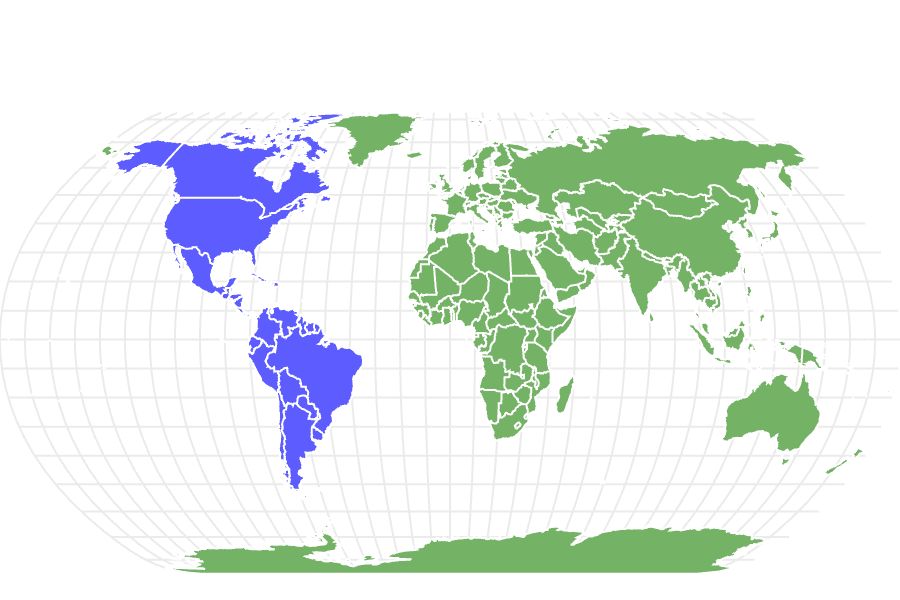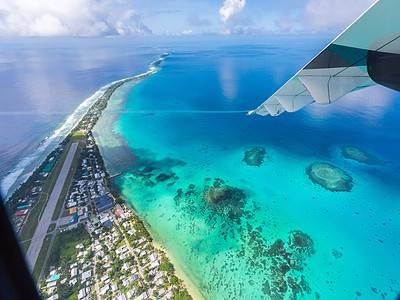Rattlesnake
Rattlesnakes may have evolved their rattle to warn bison away from them.
Advertisement
Rattlesnake Scientific Classification
Read our Complete Guide to Classification of Animals.
Rattlesnake Conservation Status
Rattlesnake Facts
- Prey
- Rodents, lizards, frogs, nestling birds
- Name Of Young
- Neonates, snakelets
- Group Behavior
- Solitary
- Solitary except during mating season
- Communal Dens
- Fun Fact
- Rattlesnakes may have evolved their rattle to warn bison away from them.
View all of the Rattlesnake images!
Rattlesnakes are easily recognized venomous snakes with a rattle at the end of their tails. As members of the pit viper group, rattlesnakes use their powerful venom to subdue their victims. This venom stops blood clotting and destroys internal tissues, quickly disabling animals they bite. Humans can also die when antivenom is not available. The most dangerous snake in this family is the Mojave rattlesnake, one with a potent neurotoxin in its venom.

6 Rattlesnake Facts
- Although their venom can seriously injure or kill humans, rattlesnakes prefer to avoid any human contact.
- These snakes can control how much venom they use when they bite, and as much as 50% of bites are ”dry,” meaning there’s no venom.
- Scientists believe that rattlesnakes evolved more recently than other snakes.
- Rattlers also make a hissing sound like a cat to warn predators to stay away.
- Rattlesnakes range in size from one foot long to over eight feet.
- Their metabolism is pretty slow and they only need to eat every two to three weeks.
Scientific Name
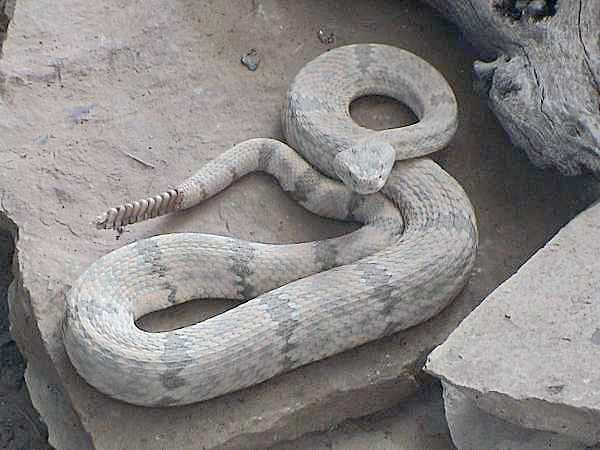
The name “rattlesnake” comes from the Middle English verb “rattle,” a word formed from the sound of loose objects hitting each other.
©Dawson / CC BY-SA 2.5 – License
Rattlesnakes are members of the Reptilia class and Viperidae family, specifically of the subfamily Crotalinae, the pit vipers. The name “rattlesnake” comes from the Middle English verb “rattle,” a word formed from the sound of loose objects hitting each other. The second half of the viper’s name is simply the Middle English word “snake,” meaning “serpent reptile.” The specific scientific name is Crotalus.
Evolution
In order to get a clear picture of the evolution of the rattlesnake, we must first look at how pit vipers, in general, evolved. Based on the oldest fossils of pit vipers that have been found, they can be placed in the Miocene Era. But Molecular phylogenies date Viperidae back further to the early Eocene Era around 56-48 million years ago. They originated in Africa, Asia, and Europe and later spread into North, Central, and South America.
Researchers believe there was an ancestral snake to modern rattlesnakes which existed around 22 million years ago. It had highly toxic venom composed of genes for toxins that could damage muscles, attack the nervous system, and poison the blood of its victims. Rattlesnakes came on the scene 12-14 million years ago but somehow shed certain neurotoxin genes, so that their venom became more specialized. For example, the venom of an Eastern or Western Diamondback rattlesnake damages muscles and blood vessels in its prey. On the other hand, the venom of the Mojave rattlesnake attacks the blood and nervous system.
So where did the rattle come from? One theory, based on the fact that some other snake species shake their tails to ward off predators, suggests that rattlesnakes developed the rattle as a more effective way to signal a warning to predators. Some scientists believe that some snakes selected a trait of retaining some extra skin at the end of their tails when they shed, which made noise when they shook it.
Types of Rattlesnakes
There are over 60 rattlesnake species; most of them fit within the genus Crotalus, the smaller Massasauga and pygmy rattlesnakes are in the genus Sistrurus.

The sidewinder is a rattlesnake that’s adapted to life in desert habitats.
©Roger de Montfort/Shutterstock.com
Crotalus genus rattlesnakes listed according to scientific name:
- Eastern Diamondback Rattlesnake (Crotalus adamanteus)
- Queretaran dusky rattlesnake (C. aquilus)
- Western Diamondback Rattlesnake (Crotalus atrox)
- Mexican west coast rattlesnake (C. basiliscus)
- Santa Catalina rattlesnake (C. catalinensis)
- Arizona black rattlesnake (C. cerberus)
- Sidewinder (C. cerastes)
- Midget faded rattlesnake (C. concolor)
- Neotropical rattlesnake (C. durissus)
- Baja rattlesnake (C. enyo)
- Southern Pacific Rattlesnake (C. helleri)
- Timber rattlesnake/canebrake (C. horridus)
- Mexican small-headed rattlesnake (C. intermedius)
- Autlan rattlesnake (C. lannomi)
- Rock rattlesnake (C. lepidus)
- Speckled rattlesnake (C. mitchelli)
- Black-tailed rattlesnake (C. molossus)
- Mexican lance-headed rattlesnake (C. polystictus)
- Twin-spotted rattlesnake (C. pricei)
- Red Diamondback Rattlesnake (Crotalus ruber) has three recognized subspecies, Cedros Island red diamond rattlesnake (C. r. exsul), San Lucan red diamond rattlesnake (C. r. lucasensis), and the red diamond rattlesnake (C. r. ruber).
- Mohave rattlesnake (C. scutulatus)
- Long-tailed rattlesnake (C. stejnegeri)
- Tiger rattlesnake (C. tigris)
- Tortuga Island rattlesnake (C. tortugensis)
- Cross-banded mountain rattlesnake (C. transversis)
- Aruba Island rattlesnake (C. unicolor)
- Prairie rattlesnake (C. viridis)
- Ridge-nosed rattlesnake (C. willardi)
Sistrurus genus rattlesnakes:
- Pygmy rattlesnake (S. miliarius)
- Massasauga rattlesnake (S. catenatus)
- Western massasauga rattlesnake (S. tergeminus)
Appearance & Behavior
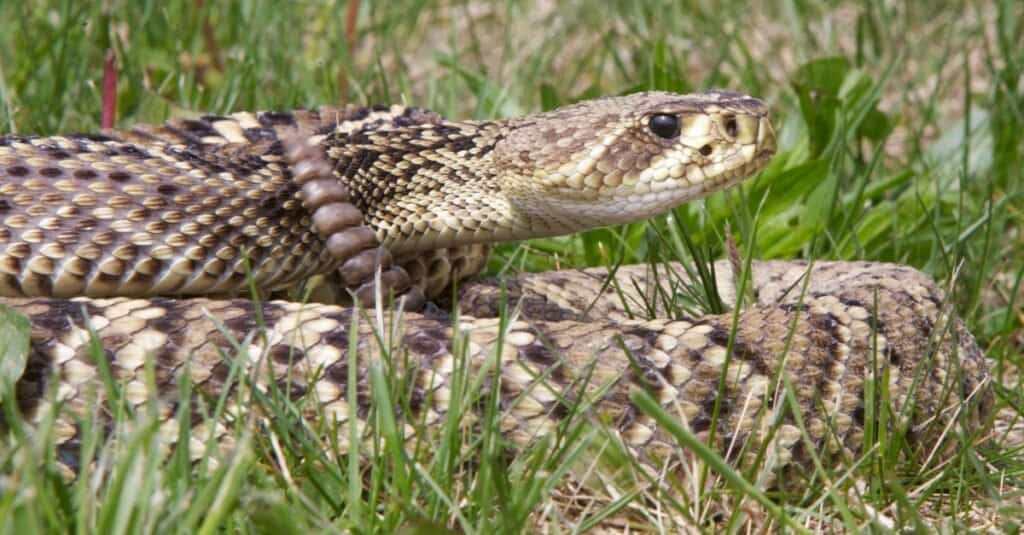
The eastern diamondback can grow up to eight feet long and can weigh as much as 10 pounds, as the largest in its species.
©iStock.com/NajaShots
There are over 60 species of rattlesnakes several dozen subspecies. All of these are native to the Americas, from southern Canada to Argentina.
Among the largest rattlesnakes are those living in the Eastern half of the United States. The timber rattlesnake typically ranges from 2.5 to five feet long, although some are recorded at as much as seven feet in length. The eastern diamondback can grow up to eight feet in length and weighs as much as 30 pounds, as the largest in its species. One of the smallest rattlesnakes is the pygmy of Florida. The pygmy averages one to 1.5 feet in length, about the same length as a domestic cat.
Rattlesnakes have thick bodies with heavily ridged scales. Their coloration varies according to their habitat. However, most have dark patterns of diamonds or other geometric shapes on a lighter-colored background.
At the end of their tails, you can see a distinctive rattle made up of hollow keratin chambers. These chambers knock together when a rattlesnake shakes its tail, making a rattling noise. The rattle gains a new segment each time the snake sheds its skin, but rattles often break due to damage caused as part of daily living in its environment.
Besides their rattler and distinctive patterned design, rattlesnakes also have triangular heads and hinged fangs. Their eyes have cat-like vertical pupils.
Rattlesnakes are not usually aggressive and most would rather flee than fight. They typically only attack humans when startled or provoked, but they don’t always rattle – sometimes there’s no time to rattle or the snake is young enough that they don’t have one. When they try to warn you away from them, their defensive display is dramatic and easy to see! Rattlesnakes hiss loudly, inflating their body to appear bigger while coiling their body and necks in preparation for a strike.

Rattlesnakes can control how much venom they emit when they bite.
©Maria Dryfhout/Shutterstock.com
Rattlesnakes vs. Other Snake Species
Rattlesnakes are often confused with other snake species that live in the same habitats. Kingsnakes are often found in the same habitats as rattlesnakes but are nonvenomous. Kingsnakes hunt rattlesnakes and use constriction to disable rattlesnakes before they can attack with their venomous bites.
Habitat
Among all rattlesnake locations, the greatest concentration of these snakes is in the southwestern states of the U.S. and the northern part of Mexico. Arizona is home to the most types of rattlesnakes, with 13 calling that U.S. state home. There are several rattlesnake species in California too.
More rattlesnakes live in the Southwest’s desert sands and dry climate than elsewhere. But many subspecies thrive in other climates and environments. They do well in grassy regions, rocky hills, swamplands, meadows, brushy areas, and even as high as 11,000 feet above sea level.
Rattlesnakes live in dens within rocky crevices. During winter in colder climates, they hibernate in their dens. For snakes, this period of rest is called brumation.
Generations of the same snake family often re-use their dens, sometimes for longer than 100 years. When they leave the den during the daytime, the snakes sunbathe on warm rocks or out in the open. When the weather becomes extremely hot during summer, they sometimes shift their schedule for more nighttime activity.
The snakes’ body patterns and colors vary according to their environment. These colors and patterns serve as camouflage to protect them from predators.
Diet
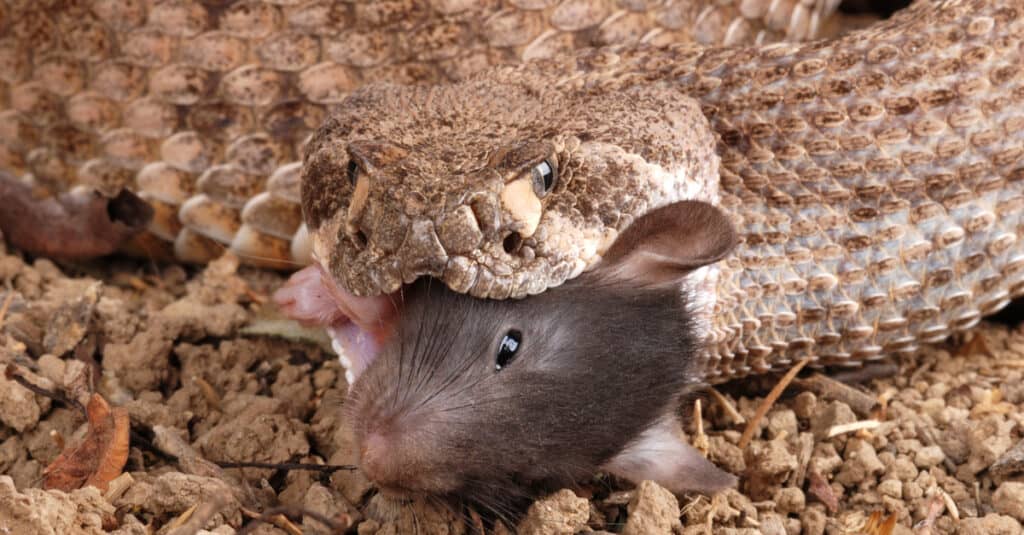
Western diamondback rattlesnakes are vital to rodent control
©Audrey Snider-Bell/Shutterstock.com
Rattlesnakes eat a wide variety of small mammals. They prefer rats, mice, birds, rabbits, and other small creatures like lizards and frogs. When not tracking a meal, they lie in wait until attractive prey passes by closely enough. These snakes do not need more than one meal every few weeks in adulthood.
Finding prey is not difficult for a rattlesnake. They have very keen eyesight and a strong sense of smell using both their nostrils and their flicking tongues. They also have heat-sensing pits near the tip of their nose. These pits sense warm-blooded animals in the environment. Despite these well-developed senses that help them hunt for prey, rattlesnakes have terrible hearing. But they can sense vibrations in the ground, such as for a human or animal walking nearby.
To capture their prey, rattlesnakes strike fast and inject their venom into the animal using large fangs and powerful jaws. The venom almost immediately paralyzes the prey. It only takes half a second for the snake to strike and render its food immobile. Then, the snake swallows the food whole and retreats to its den or another safe and quiet place to digest its meal. Digestion takes several days and makes the rattler sluggish.
Although about 8,000 rattlesnakes bite humans each year, they do not attack humans as prey. Of those, only about five dies in a given year. Proper attention must be given to pets that fall victim to rattlesnake bites.
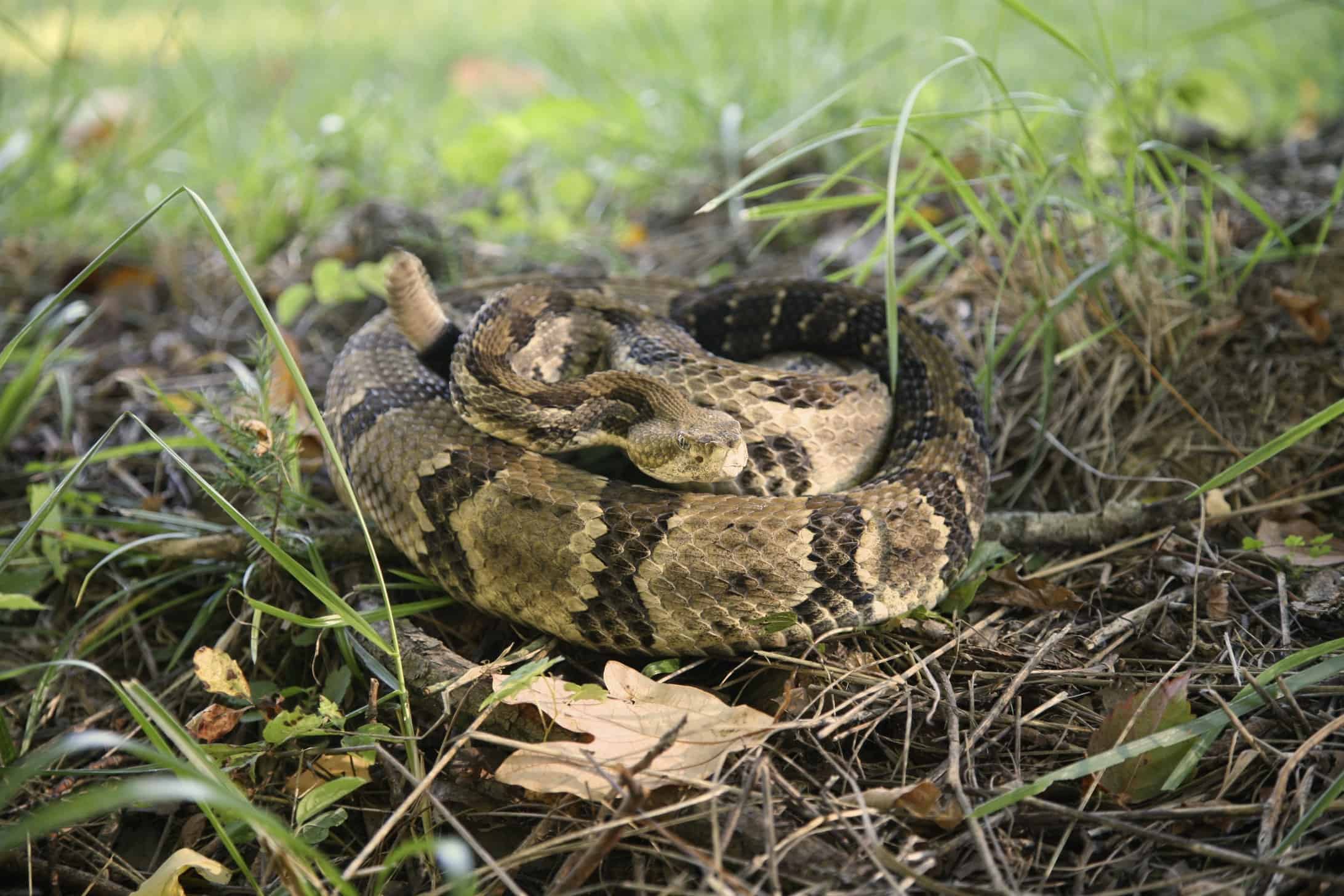
Timber Rattlesnakes are extremely venomous, but they are not typically aggressive.
©iStock.com/NajaShots
Predators & Threats
One of the biggest predators of rattlesnakes in the wild is the king snake. Black snakes also attack and eat rattlers. One popular belief is that bullsnakes will eat rattlesnakes, but this is purely a myth.
Owls, eagles, and hawks also prey upon rattlesnakes. Predatory birds can swoop down from overhead to grab a snake in their strong talons and carry it away. Wild cats, foxes, coyotes, and even turkeys also enjoy feasting on rattlesnake meat.
Big animals and humans tend to avoid rattlesnakes. The snakes’ telltale hiss and tail rattle give plenty of warning for the animals to move away. While hooved animals like bison do sometimes stomp on rattlesnakes, they prefer to avoid them. Rattlesnake venom is dangerous to people, and untreated bites can result in death, but most snakebite deaths occur because the individual failed to seek treatment. Some diners enjoy the taste of rattlesnake meat. Others use the reptiles’ skins to make boots, shoes, belts, handbags, and other material goods.
Another threat to the rattlesnake is urban development. Development by humans takes over the snake’s habitat and encroaches on their hunting grounds. One of the biggest killers of rattlesnakes is traffic. Many are run over by cars each year.
Several species of rattlesnakes are listed as endangered or vulnerable in the U.S. These include the timber rattlesnake and massasauga rattlesnakes.
How to Avoid Rattlesnakes in their Habitat
Rattlesnakes range from Canada to Argentina, so if you’re the outdoors type, you may encounter a rattlesnake across much of not only the United States but the Americas. If hiking, the best advice for avoiding rattlesnakes is to stay on trails. Most encounters where rattlesnakes bite occur because they’re startled. If you do come close to one, avoid sudden movements and back away. Rattlesnakes are not aggressive and will not pursue.
Reproduction, Babies, and Lifespan
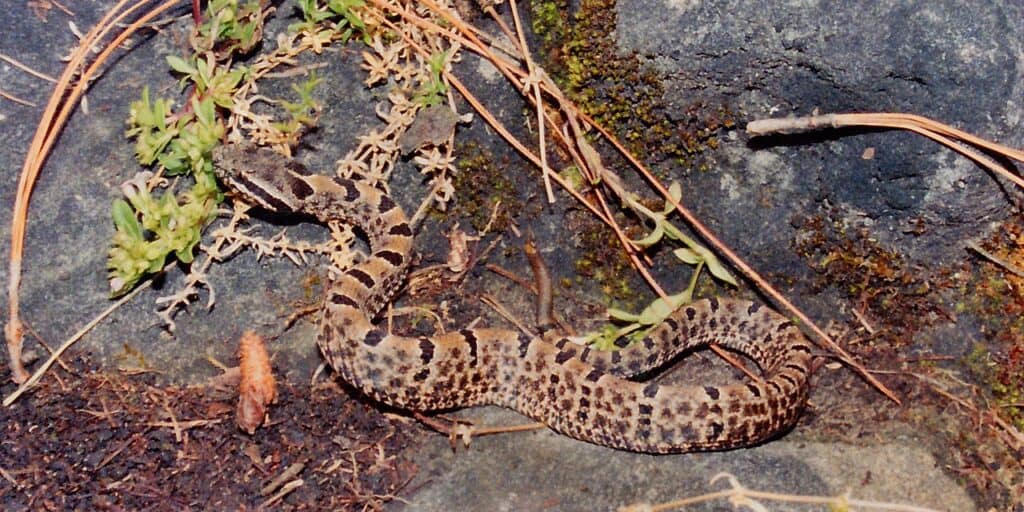
When a baby rattlesnake starts shedding its skin, its rattle develops and grows longer with each skin shedding.
©William L. Farr / CC BY-SA 4.0 – License
Female rattlesnakes only reproduce every one to three years. This mating usually takes place during summer or fall. But some species mate in spring or both spring and fall.
To find an appropriate mate, females secrete sex pheromones. This leaves a scent trail that the males follow using their advanced sense of smell. When the male locates the female, he follows her for several days. Throughout this time, he often touches or rubs her to make his intention known.
Sometimes males compete for females by fighting each other. The male snakes do a “combat dance” that involves wrapping their bodies around each other. Large males easily scare smaller males away.
Rattlesnakes do not lay eggs. Instead, the female produces eggs in her ovaries like humans. But they release multiple eggs in a continuous chain into their oviduct, a tube. The male sperm fertilizes these eggs. Fertilized eggs usually gestate in the female for 167 days. When the babies are at full term, the eggs hatch inside the female. Then, the female gives birth to about 10 to 20 live baby snakes.
Instead of a rattle, baby rattlesnakes are born with a “pre-button.” When the baby starts shedding its skin, their rattle develops and grows longer with each skin shedding. Rattlesnakes live in the wild for a range of 10 to 25 years.
Population
Rattlesnake populations are generally healthy across the United States and listed as “stable” in numbers. That is, for all sub-species except the timber rattlesnake. The timber rattler once lived in 31 states. Now, it is listed as endangered in Virginia, Connecticut, Ohio, Indiana, Massachusetts, New Hampshire, Minnesota, New Jersey and, Vermont. The snakes no longer exist in Maine and Rhode Island. Massachusetts counts only 200 timber rattlesnakes left in the state.
Rattlesnake FAQs (Frequently Asked Questions)
How do rattlesnakes compare to other longer snakes like coachwhip snakes?
The main difference between a rattlesnake and a coachwhip snake is their appearance and the fact that rattlesnakes are venomous. Rattlesnakes are thicker than coachwhips and weigh more even though the two snakes can grow to about the same length.
What snakes look like Rattlesnakes?
Other snakes that are commonly mistaken for rattlesnakes include:
- Gopher snakes
- Eastern indigo snakes
- Cottonmouths
- Copperheads
- Hognose snakes
- Northern water snakes
- Eastern milk snakes
- Rat snakes
Do Rattlesnakes come out at night?
Rattlesnakes have heat-sensing organs that allow them to hunt in a variety of environments. So rattlesnakes will come out at night, but they’ll also hunt during the day. Rattlesnake species are generally not nocturnal or diurnal.
Can Rattlesnakes swim?
Rattlesnakes aren’t as aquatic as cottonmouths, but they still can swim. In fact, all snakes can swim! Yet, some are found in water much more. Rattlesnakes mostly swim to get from point A to point B and don’t hunt in aquatic environments like other snake species.
Rattlesnakes vs. cats
Pet owners in areas with rattlesnakes often worry about their cats. With rattlesnakes and other venomous snakes common across many states, this isn’t a misguided fear. The truth is that cats stand up very well to rattlesnakes, which generally prefer smaller prey. However, if you fear your cat has encountered or been bitten by a rattlesnake you should immediately take it to a vet that can treat the cat with antivenom.
Rattlesnakes vs gopher snakes
While rattlesnakes are venomous, gopher snakes are non-venomous. However, gopher snakes are more aggressive.
Are rattlesnakes carnivores, herbivores or omnivores?
Rattlesnakes are carnivores. They eat small mammals. Favorite meals include lizards, frogs, birds, rats, mice and rabbits. They use their fangs to inject venom into their prey. The venom immediately paralyzes the animal. The rattlesnake then swallows the prey whole and slithers into its den or other quiet area for digestion. Digestion takes several days. The snake does not require another meal for two to three weeks.
Can a rattlesnake kill you?
Rattlesnakes rarely kill people, although the venom can be deadly. Today, doctors use antivenom, also called anti-venom, when someone is bitten by a rattlesnake. People sometimes lose a limb or suffer organ damage from a rattlesnake bite. But of the 7,000 to 8,000 people bitten each year in the United States, only about five die. Children are most vulnerable to rattlesnake bites, since they have a smaller body size in which the dose of venom circulates.
What do you do if you see a rattlesnake?
If you see a rattlesnake, first freeze in place. This allows the snake to move away if it chooses to do so. Rattlesnakes do not want contact with humans and often slither away if given the chance to do so. If the snake holds its ground, starts rattling or hissing, slowly back away from it in retreat. If you suffer a snakebite, you must go to a hospital emergency room immediately for antivenom.
What does a rattlesnake sound like?
A rattlesnake gets its name from the rattling sound it makes using its tail. The tail has a multi-chambered rattle made of keratin. These chambers are hollow and knock onto each other when the snake twitches its tail. The sound is very much like a baby’s toy rattle. At the same time, rattlesnakes often make a hissing sound like a domestic cat. This hissing comes from the snake’s throat. Except when threatened and using its rattler or hiss, a rattlesnake lives a silent life.
What Kingdom do Rattlesnakes belong to?
Rattlesnakes belong to the Kingdom Animalia.
What phylum do Rattlesnakes belong to?
Rattlesnakes belong to the phylum Chordata.
What class do Rattlesnakes belong to?
Rattlesnakes belong to the class Reptilia.
What family do Rattlesnakes belong to?
Rattlesnakes belong to the family Viperidae.
What order do Rattlesnakes belong to?
Rattlesnakes belong to the order Squamata.
What genus do Rattlesnakes belong to?
Rattlesnakes belong to the genus Crotalus.
What is an interesting fact about Rattlesnakes?
Rattlesnake venom digests its prey before it even swallows it!
How do Rattlesnakes have babies?
Rattlesnakes lay eggs.
Roadrunner Vs Rattlesnake: Who Would Win in a Fight?
A roadrunner would win a fight against a rattlesnake. In fact, roadrunners are one of the few animals that regularly attack and kill a rattlesnake. A roadrunner must be careful when attacking a rattlesnake because if they get bitten, they will die.
What's the difference between a rattlesnake and a cottonmouth?
The main differences between a cottonmouth and a rattlesnake are their preferred habitats and physical appearances. Cottonmouths have white mouths, and rattlesnakes have rattles on the ends of their tails.
What's the difference between a rattlesnake and a copperhead?
The main difference between a copperhead and a rattlesnake is the presence of a rattle. Rattlesnakes have a rattle and live in more locations compared to copperhead snakes.
What's the difference between a rattlesnake and a king cobra?
There are many differences between a king cobra and a rattlesnake, including their habitats. King cobras have a distinct hood that they use to ward off predators, while rattlesnakes use a rattle.
What's the difference between a rattlesnake and a garter snake?
There are many differences between a garter snake and a rattlesnake, including their venom levels. Garter snakes have rounded heads and pupils, while rattlesnakes have triangular heads and a rattle on their tails.
When Do Rattlesnakes Come Out?
Rattlesnakes come out in early spring and stay active until early fall.
Would a mongoose defeat a rattlesnake?
Mongoose species are found across most of Africa, in Spain, and parts of Asia while rattlesnakes are found in the Americas, so the two species wouldn’t meet in the wild unless they were introduced to new habitats. That being said, it’s likely a mongoose would be the victor in a fight against a rattlesnake. In the wild, mongooses are extremely effective hunters of snakes and show some resistance to venom.
Who would win a fight between a black mamba and a rattlesnake?
A black mamba would win a fight against a rattlesnake due to its length and potent venom. A fight between these two would be decided by the ability to land that first strike and make it deadly.
Who would win a fight between a rattlesnake and an alligator?
An alligator would win the fight against a rattlesnake.
Alligators have the advantages over rattlesnakes in size, speed, and defense. Their protective body coating would make it exceptionally difficult for a rattlesnake to deliver the venom it would need to inject to win the fight. Alligators’ oversized form and capacity for speed would be strong factors in defeating these venomous serpents. They’ve been known to consume venomous pit vipers like rattlesnakes, apparently resistant to any ill effects of their venom.
Which is more venomous between rattlesnakes and black mambas?
Black mambas are more venomous than rattlesnakes.
What's the difference between a rattlesnake and a puff adder?
The key differences between Rattlesnakes and Puff Adders are in terms of classification, size, range, and habitat.
Let’s explore these differences here.
What's the difference between a rattlesnake and an anaconda?
The key differences between a Rattlesnake and an Anaconda are classification, size, habitat, range, and appearance. They both possess venom, but one has a higher risk of exposure to humans than others.
The differences are explained here.
What's the difference between a viper and a rattlesnake?
The key differences between vipers and rattlesnakes are location, size, appearance, reproduction, behavior, and venom potency.
Which is more venomous between a king cobra and a rattlesnake?
King cobras are more venomous than rattlesnakes. Their venom is both potent and comes in higher quantities. However, king cobra bites are rare, much rare than rattlesnake bites. So, pound for pound, the king cobra is more venomous than the rattlesnake, but the rattlesnake presents more of a threat to humans.
What's the difference between a rattlesnake and a Gaboon viper?
The greatest differences between a Gaboon viper and a rattlesnake are their morphology and location.
Gaboon vipers are venomous snakes in sub-Saharan Africa, known for their broad, leaf-shaped head, horns between their nostrils, and thick, heavy bodies. Rattlesnakes are endemic to the Americas, possess a triangular head, have a thick body, and have a distinct rattle on the end of their tail that is used as a defensive warning.
Who would eat who: Tarantula vs Rattlesnake?
A tarantula would win the fight against a rattlesnake.
Even though the rattlesnake is bigger and faster, the tarantula’s hunting skills counterbalance the fact that it is slower than the rattlesnake. The tarantula’s hunting techniques are a clear advantage. It can quickly ambush the rattlesnake, biting it by the head. The rattlesnake, in turn, can’t do anything to escape.
Which is more venomous: Rattlesnakes vs Vipers?
Considering both species’ venoms, it is safe to say that rattlesnakes aren’t more venomous than vipers. Also, since rattlesnakes are of the Viperidae family, if they were the most dangerous vipers, they would be known as the most venomous rattlesnake as well as the most venomous viper.
Thank you for reading! Have some feedback for us? Contact the AZ Animals editorial team.
Sources
- David Burnie, Dorling Kindersley (2011) Animal, The Definitive Visual Guide To The World's Wildlife
- Tom Jackson, Lorenz Books (2007) The World Encyclopedia Of Animals
- David Burnie, Kingfisher (2011) The Kingfisher Animal Encyclopedia
- Richard Mackay, University of California Press (2009) The Atlas Of Endangered Species
- David Burnie, Dorling Kindersley (2008) Illustrated Encyclopedia Of Animals
- Dorling Kindersley (2006) Dorling Kindersley Encyclopedia Of Animals

